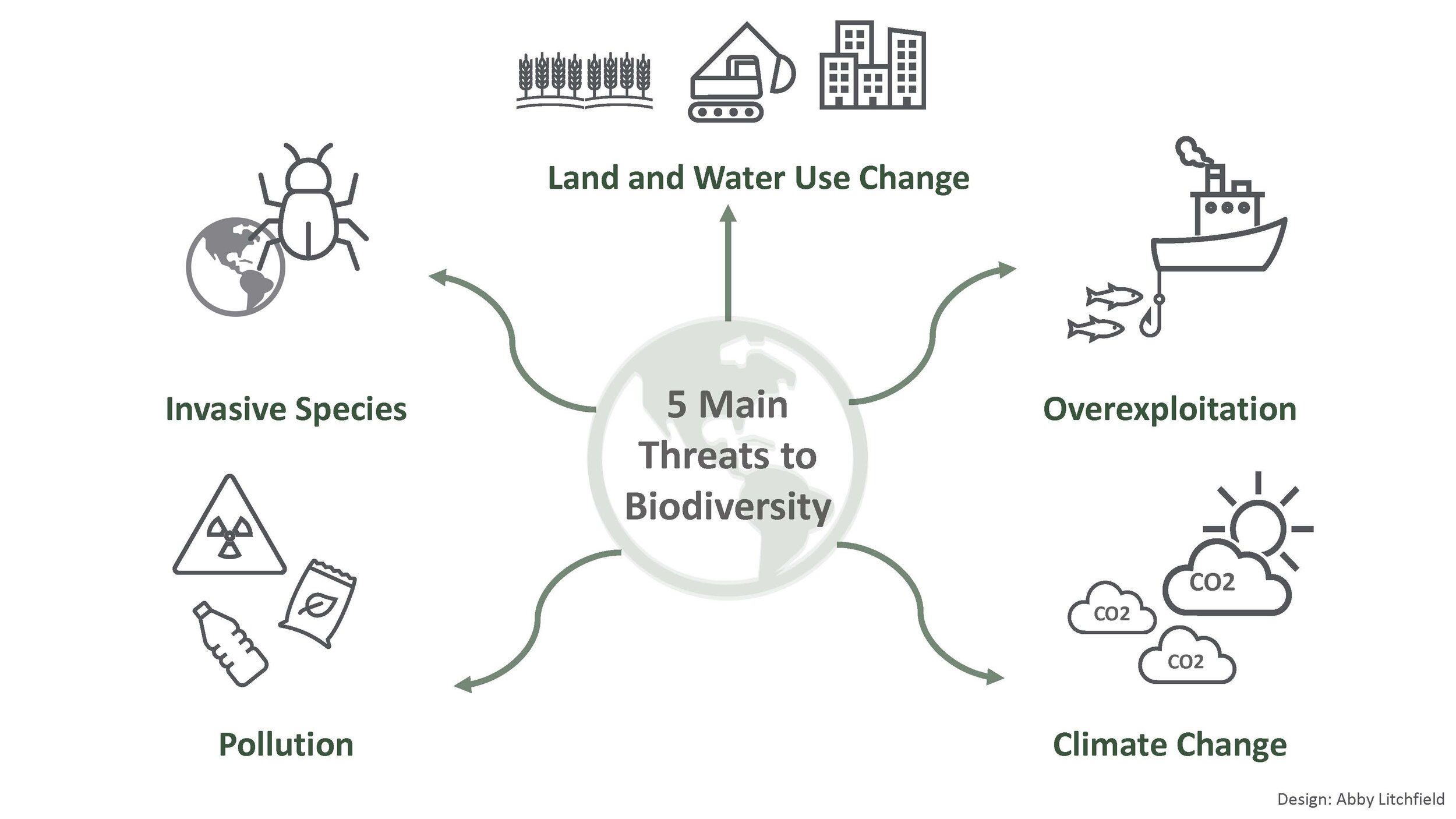Threats to biodiversity are mounting. Businesses need to understand the dangers—and the opportunities for action.
“The Basics” provides essential knowledge about core business sustainability topics.
Hands up if you can name this little-known member of the world economy:
Every year, it provides services valued at between USD $120-$140 trillion—more than 1.5 times the entire annual global GDP.
More than 55% of the world’s GDP depends on its services.
It is by far the cheapest and most effective source of the services it offers—and it is in danger of going out of business.
This vital component of the economy is biodiversity. Biodiversity is the variety of living things. It means the many forms of life that exist in a given area and on the planet overall, and the ways in which that life is supported. An area with good biodiversity will have many different forms of life in it: animals, plants, fungi, and others. These diverse species are all linked to each other in a network called an ecosystem.
Different types of ecosystems support business sectors ranging from food and clothing to insurance and tourism. Economists call the economically valuable goods and services that ecosystems supply “ecosystem services.” These services include crop pollination, flood protection, and water purification. When there is enough biodiversity to keep these ecosystems working well, they can provide trillions of dollars’ worth of services every year.
Biodiversity and ecosystem services are threatened
But ecosystem services are shutting down as species go extinct and the ecosystems grow weakened or unbalanced. The costs to businesses are massive. For example, in every year from 1997 to 2011, declines in biodiversity from just two causes—changes in land use and damage to the land from those changes—led to ecosystem services losses valued at USD $10-$31 trillion.
Business and biodiversity depend on each other. Businesses need functioning, diverse ecosystems for their operations and supply chains. At the same time, the way that businesses operate and obtain those supplies affects whether the ecosystems will stay healthy or not.
This article describes the main threats to biodiversity and what they mean for your business.
What are the main threats to biodiversity?
Scientists have named five main threats to biodiversity. Knowing what they are and how they work can help you identify ways your company’s practices might be contributing to declines in biodiversity, as well as areas where you can change.

The threats are:
Changes to how we use the land and waters. Both our lands and our seas contain many different ecosystems, and these are affected by business actions. For example: when developers drain and fill in marshes or wetlands in order to build housing, they take away the land that captures excess water during storms. The consequences can be drastic. When Superstorm Sandy hit New York and New Jersey in 2012, coastal marshland reduced damages by 27% (USD $430 million) in New Jersey, which had kept quite a bit of its marshes. In New York, where almost all the marshes had been drained and developed, marshland protection reduced damages by only 0.4% ($140 million).
Overexploitation and unsustainable use. Activities such as logging, farming, and fishing can be done sustainably, but they are often done in ways that overexploit a resource. When too many species, or even just a few important species, are taken out of the ecosystem, the whole network of life in that area can collapse. (Think of a rock wall with too many rocks taken out, or a spider web with too many strands cut.) Overall, people have been taking far more from nature than it can afford. For example, 70% of fish stocks in the ocean are currently being overfished. A 2016 study suggested that the oceans could be empty of fish by 2050.
Climate change. We’re already seeing hotter temperatures, warmer oceans, and more severe weather events. Many species can’t adjust to these conditions, and their numbers crash. The species endangered include many pollinating insects, which contribute $235-$577 billion in ecosystem-services value to the global economy every year.
Increased pollution. Pollution of air, soil, and water poses a serious problem to many ecosystems. Tiny bits of plastic suspended in ocean water build up inside fish, birds, and other marine species. Industrial toxins kill many species in rivers and lakes. Air pollution makes its way into soil, leaves, and water. It all adds up to fewer species, less diversity, and weakened ecosystems.
Invasive species. Global trade brings species from their home ecosystems to other parts of the world, where there are often no predators to eat them and keep their numbers in check. The warming climate allows dangerous species such as disease-carrying mosquitos to thrive in new latitudes. Alien species often throw their new habitats severely out of balance. For instance, the brown rat, which originated in central Asia and has invaded almost every part of the world, has driven hundreds of species extinct and causes an estimated $19 billion in damage each year in the United States alone.
How does biodiversity loss threaten business?
All businesses depend on the ecosystem services that biodiversity provides, whether directly or indirectly. So, as a report for the World Economic Forum notes, the steep decline in biodiversity “will inevitably impact bottom lines—for example, through reduced fish stocks disrupting commodity supply chains, economic losses from disasters such as flooding, and the loss of potential new sources of medicine.”
Some of the risks posed to business by biodiversity loss are:
Operational risks: Many raw materials are becoming scarce or unavailable because of overexploited or disturbed ecosystems. In 1992 the Atlantic cod stock collapsed to just 5% of the former cod population; this ended 500 years of cod fisheries in Atlantic Canada and put nearly 30,000 people out of work in Newfoundland alone.
Regulatory risks: Countries are limiting and regulating the use of certain raw materials and business activities. For example, several countries in Southeast Asia have imposed partial or total logging bans in recent years.
Market and reputational costs: Customers increasingly demand that businesses operate in environmentally sustainable and ethical ways. One study shows that 87% of consumers worldwide want companies to protect biodiversity with their sourcing practices.
Reduced access to capital and loss of investment opportunities: Lenders and investors, like consumers, increasingly demand assurances that companies are acting sustainably. More major companies, including BNP Paribas SA and AXA, are signing onto biodiversity-protection initiatives such as Business for Nature and committing to taking companies’ sustainability records into account when making investment decisions.
Increasing insurance costs: Loss of the “ecosystem service” of storm and ocean-rise protection costs insurers billions of dollars every year. Much of this cost is passed on to companies.
How can businesses reduce threats to biodiversity—and find opportunities?
Businesses benefit from biodiversity and ecosystem services. And they can also benefit from protecting and restoring them. Integrating biodiversity considerations into strategy, operations, supply chains, and investment decisions can lead to new business services, products, and models.
Here are some ways that businesses are capitalizing on these opportunities:
1. Sourcing materials sustainably for business longevity
Following best practices in sustainably collecting materials can increase a company’s resilience. Cosmetics manufacturer L’Oréal, which gets the raw materials for its products from nearly 340 species of plants originating in 100 countries, has a new sustainable-sourcing policy that aims for zero deforestation. This is helping the company build long-term partnerships and strengthen its social systems.
2. Innovating to create and expand profitable new markets
Increasingly, consumers and investors are demanding ethical and sustainable products and services. That mean new business models, products, services, revenue streams, and technologies. Trading in carbon credits is an example of a new biodiversity-friendly market. These credits can help protect forests, the climate, and communities. The carbon-offsets market is predicted to be worth $200 billion globally by 2050.
3. Improving relationships with society
Some businesses are showing great leadership in creating and joining partnerships for ecosystem protection and regeneration. Broad-based partnerships include the Global Partnership for Business and Biodiversity, Business for Nature, and the One Planet Business for Biodiversity (OP2B) coalition. These efforts can strengthen relationships with essential stakeholders, from employees to regulators.
The way forward: global partnerships for business and biodiversity
The threats to biodiversity are real. But increasingly, businesses, individuals, and organizations are finding innovative, collaborative ways to protect the planet. Excellent models exist. Ultimately, we need accelerated action and collaboration at scale in order to sustainably use, conserve, and restore biodiversity.
Creating better business in this way will help to achieve many common societal goals, including those underpinned by the Sustainable Development Goals. Get involved to turn threat to opportunity and create a better planet for all.
Reports on business and biodiversity
Brondizio, E. S., Settele, J., Díaz, S. and Ngo, H. T. (editors) (2019). Global assessment report on biodiversity and ecosystem services of the Intergovernmental Science-Policy Platform on Biodiversity and Ecosystem Services. IPBES.
Almond, R.E.A., Grooten, M. and Petersen, T. (editors) (2020). Living Planet Report 2020 – Bending the curve of biodiversity loss. WWF.
World Economic Forum. (2020). Nature Risk Rising: Why the Crisis Engulfing Nature Matters for Business and the Economy.
World Economic Forum. (2020). New Nature Economy Report II: The Future of Nature and Business. Report No. 2.
Bateman, I. J. (coordinating lead author), et al. (2011). Chapter 22: Economic values from ecosystems. The UK National Ecosystem Assessment.
OECD. (2019). Biodiversity: Finance and the Economic and Business Case for Action. Report prepared for the G7 Environment Ministers’ Meeting, 5-6 May.
About the Series
“The Basics” provides essential knowledge about core business sustainability topics. All articles are written or reviewed by an expert in the field. The Network for Business Sustainability builds these articles for business leaders thinking ahead.



Add a Comment
This site uses User Verification plugin to reduce spam. See how your comment data is processed.This site uses User Verification plugin to reduce spam. See how your comment data is processed.